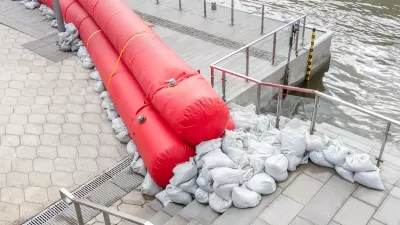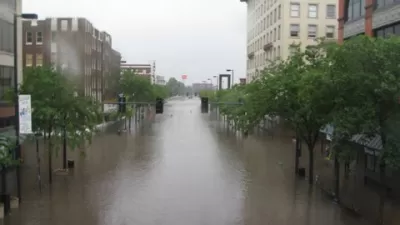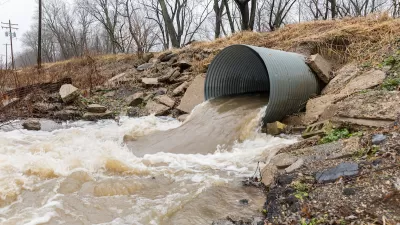Flooding causes over $400 billion in damage in the United States every year.

Flooding is becoming increasingly deadly and costly for American communities. In recent years, the cost of flooding has reached almost $496 billion annually.
In an article in Governing, Carl Smith explains how the crisis is reaching more places — even some thought to be ‘climate havens’ — and how cities are taking action to protect their residents and infrastructure.
To both prepare for potential flooding and conserve water to ensure a steady supply during droughts, cities are building ‘green’ stormwater infrastructure that returns water to the soil and channels it to retention ponds rather than letting it drain to lakes or oceans.
Because watersheds cross multiple jurisdictions, policymakers and planners need to collaborate across cities, counties, and states. “Stormwater needs to be considered as part of the larger water picture. Runoff from city streets or farmland can pollute drinking water. Floods can overwhelm wastewater systems. Ideally, these systems can be integrated in ways that create savings rather than damage. Stormwater retention can recharge aquifers and all sorts of recycled water can be used for drinking.”
FULL STORY: Flooding Is a $400 Billion Problem That's Getting Worse

Maui's Vacation Rental Debate Turns Ugly
Verbal attacks, misinformation campaigns and fistfights plague a high-stakes debate to convert thousands of vacation rentals into long-term housing.

Planetizen Federal Action Tracker
A weekly monitor of how Trump’s orders and actions are impacting planners and planning in America.

San Francisco Suspends Traffic Calming Amidst Record Deaths
Citing “a challenging fiscal landscape,” the city will cease the program on the heels of 42 traffic deaths, including 24 pedestrians.

Defunct Pittsburgh Power Plant to Become Residential Tower
A decommissioned steam heat plant will be redeveloped into almost 100 affordable housing units.

Trump Prompts Restructuring of Transportation Research Board in “Unprecedented Overreach”
The TRB has eliminated more than half of its committees including those focused on climate, equity, and cities.

Amtrak Rolls Out New Orleans to Alabama “Mardi Gras” Train
The new service will operate morning and evening departures between Mobile and New Orleans.
Urban Design for Planners 1: Software Tools
This six-course series explores essential urban design concepts using open source software and equips planners with the tools they need to participate fully in the urban design process.
Planning for Universal Design
Learn the tools for implementing Universal Design in planning regulations.
Heyer Gruel & Associates PA
JM Goldson LLC
Custer County Colorado
City of Camden Redevelopment Agency
City of Astoria
Transportation Research & Education Center (TREC) at Portland State University
Jefferson Parish Government
Camden Redevelopment Agency
City of Claremont





























